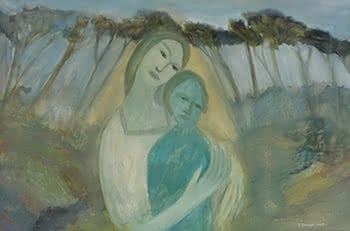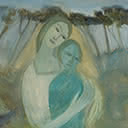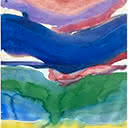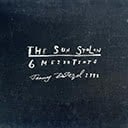Ao Tahi, First Light
80 x 120 cm
est. $25,000 - 35,000
Born in Otorohanga in 1973, Star Gossage was named for the whetū maramā, the star with five differently coloured points that sits above the crescent moon to symbolise the Ratana faith. Creativity was bred into her. Peter Gossage (1946-2016), her Pakehā father, worked as a scenic artist and graphic designer for TV2 during the 1960s. He met and married Josephine, known as Tilly, a descendant of Rahui Te Kiri Tenetahi (and also an artist), in a Ratana ceremony conducted in Herne Bay in 1971. Peter produced illustrated children's books telling Māori stories at Tilly's suggestion, instilling matauranga Māori into the imaginations of Star and their four other children, Marama, Ra, Tahu and Aroha, as well as a generation of other New Zealanders. Several of the Gossage siblings are artists, living on their ancestral Te Kiri land at Pakiri, north of Auckland. From the beach there, they look towards Te Hauturu-o-Toi (resting place of the wind) or Little Barrier Island, which was once was home to Ngāti Manuhiri, Ngāti Rehua and Ngāti Wai before it was taken and made a nature reserve by the Crown in 1895.
Star's works reverberate with the wairua or spirit of her Ngati Wai and Ngati Ruanui tupuna but also acknowledge her French, Portuguese, Spanish and English ancestry. She developed her practice at the School of Art in Dunedin where she studied in the early 1990s, mixing found materials such as lime and clay into house paints to build texture into her surfaces. Stylistically her figures resemble those of Dunedin's Patricia France (1911-1995), an artist who was encouraged to begin painting in her mid-fifties to overcome the depression that had brought her to Ashburn Hall. Like Pat France, Star is influenced by the mysterious and evocative work of the French Symbolist painter Odilon Redon (1840-1916) and the surrealism of Russian-French artist Marc Chagall (1887-1985).
Female subjects predominate in both Gossage and France's work, usually integrated with their environment, as the mother and child with the silhouetted manuka trees are here in the painting 'Ao Tahi' (literally "first light" or dawn). 'Oi boy' from 2008 is an exception, with a seated male figure dominating the composition, his expression dreamy and introspective as he holds a feather quill up in his left hand, seemingly untroubled by being shouted at.
Built into these works is mea tinana or the physical matter (detritus) from the studio at Pakiri which adheres to the surface. In this way, the works carry the materiality of where they were made out into the world, anchoring the paintings in the reality of lived experience. This counters the ethereal appearance of the figures, achieved through thinning oil paint to suggest a dream or vision. Here are the artist's own symbolic representations rather than literal depictions of Hinetitama (the goddess of the dawn) or distinct identities. Smudging and scrubbing away at the outlines of her forms, Star blends mother and child together, cloaking them in the golden light of dawn. The closeness of this matrilineal bond contrasts with the separateness of her male figure, the sky behind his head alight with inspiration. Sensibility suffuses these paintings, honouring gentleness and quiet, and balancing masculine and feminine qualities.
LINDA TYLER





